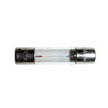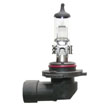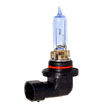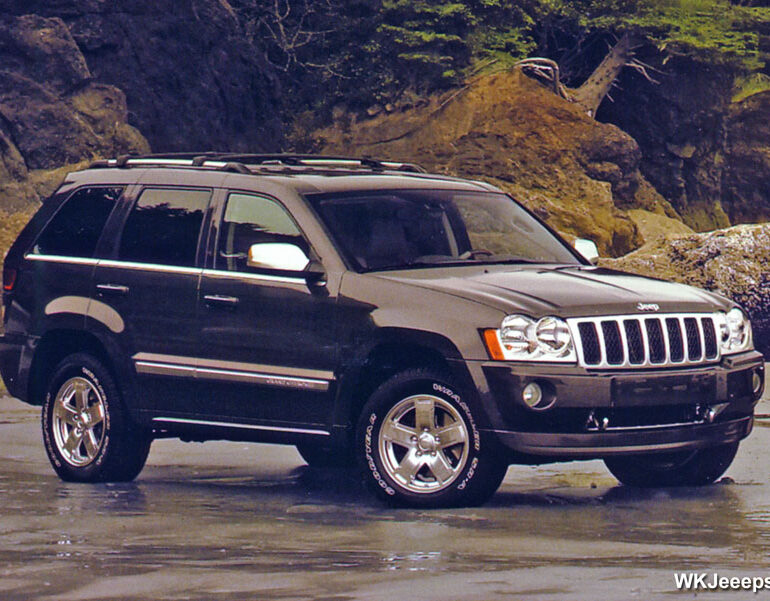Welcome to the JeepSpecs.com in-depth table on WK Generation Jeep Grand Cherokee lamps and lighting. Did we miss anything? Please get in touch with us and tell us about it!
| Interior bulbs | |||||||
| Bulb | Description | Qty | Bulb P/N / Jeep P/N | Volts | Amps | Watts | |
| Liftgate lamp | 1 | 5795023881AA | 12 | 0.75 | 9 | ||
 |
Courtesy (under dash) | 2 | 906L0000906 | 13 | 0.69 | 8.97 | |
| Dome / Reading – Front (overhead console) | 2 | WL-578L0000578 | 12 | 0.75 | 9 | ||
| Dome / Reading – Rear (assist handle) | 2 | W10/5L002825W5W | 12 | 0.75 | 9 | ||
 |
Glove compartment | 1 | 194L0000194 | 14 | 0.27 | 3.78 | |
 |
Sunvisor vanity | 2 | V263776501966 | ||||
| Exterior bulbs | |||||||
| Bulb | Description | Qty | Bulb P/N / Jeep P/N | Volts | Amps | Watts | |
 |
Back-up (2005-2006) | 2 | 3157 or 3157K(K= long life) |
12.8-14 | 2.1 | 28 | |
 |
Back-up (2007-2009) | 2 | 921L000921E | 12.8 | 1.4 | 17.92 | |
 |
Brake / tail | 2 | 3157 or 3157K(K= long life) |
12.8-14 | 2.1 | 28 | |
 |
Fog lamp bulb (front) | 2 | 9145 / H10L0009145 | 12.8 | 3.75 | 45 | |
| Fog lamp bulb (rear) | 2 | P-25-10153622 or L0007506 |
12 | 1.75 | 21 | ||
 |
Headlamp – Low | 2 | 9006L0009006 | 12.8 | 4.25 | 55 | |
 |
Headlamp – High | 2 | 9005L0009005 | 12.8 | 5 | 65 | |
 |
Headlamp – Low (HID) | 2 | D1S04865941AC | 35 | |||
 |
License plate | 2 | 168L0000168 | 14 | .35 | 4.9 | |
 |
Parking / Side marker (front) | 4 | 194NA or 194NAK(NA= natural amber) (K= long life)L0000194 |
14 | 0.27 | 3.78 | |
 |
Stop lamp (center high) | 1 | 9210154883AA | 12.8 | 1.4 | 17.92 | |
 |
Turn signal (front) | 2 | 3157A or 3157AK(A= amber) (K=long life) |
12.8-14 | 2.1 | 28 | |
 |
Turn signal (rear) | 2 | 3157 or 3157K(K= long life) |
12.8-14 | 2.1 | 28 | |
| NOTE: Bulb part numbers shown in Blue are factory part numbers. Bulb part numbers shown in RED text signify the availability of aftermarket replacement bulbs in custom colors. Custom and replacement bulbs are available from a variety of different online companies, several of which are listed in the Links section below.Important: Before replacing any automotive bulbs with types or styles other than what the manufacturer has specified or recommended, be sure to check local and Federal laws governing vehicle lighting. An excellent reference web site for this information can be found here: Motor Vehicle Lighting Standards. | |||||||
Exterior lighting – technical descriptions
AUTOMATIC HEADLAMPS
The optional automatic headlamp (auto low) system includes the Steering Control Module (SCM), the Front Control Module (FCM), the left (lighting) multi-function switch and, depending upon vehicle equipment either the sun load sensor on the top of the instrument panel or the Rain Sensor Module (RSM) on the inside of the windshield below the electrochromic inside rear view mirror mounting button. First, the Auto Low option must be enabled using the customer programmable features function of the Electronic Vehicle Information Center (EVIC). Then the A (Automatic) position must be selected using the left multi-function switch.
Once these prerequisites have been met, the SCM responds by sending the appropriate electronic lighting request messages to the FCM over the Controller Area Network (CAN) data bus and, either the sun load sensor provides an ambient light level input to the ElectroMechanical Instrument Cluster (EMIC) (also known as the Cab Compartment Node/CCN) which is relayed to the FCM over the CAN data bus, or the RSM provides electronic ambient light level messages to the FCM over the CAN data bus. With the engine running, the FCM responds to these messages by automatically controlling a pulse width modulated voltage output to the selected headlamp bulbs through the right and left low beam feed circuits to illuminate the headlamps. The FCM also sends the appropriate electronic messages back to the EMIC to control the illumination of the high beam indicator.
BACKUP LAMPS
The backup (or reverse) lamps have a path to ground at all times through a takeout and eyelet terminal of the body wire harness that is secured by a ground screw to the body sheet metal. The PCM continually monitors a hard wired multiplex input from the Transmission Range Sensor (TRS), then sends the proper electronic transmission gear selector status messages to other electronic modules over the CAN data bus. Whenever the ignition switch is in the ON position and the FCM receives an electronic message indicating the status of the transmission gear selector is REVERSE, it provides a battery voltage output to the backup lamps on the backup lamp feed circuit.
BRAKE LAMPS
The brake (or stop) lamps and the Center High Mounted Stop Lamp (CHMSL) each have a path to ground at all times through a takeout and eyelet terminal of the body wire harness that is secured by a ground screw to the body sheet metal within the passenger compartment. The brake lamps and CHMSL receive battery voltage on the brake lamp switch feed circuit when the brake lamp switch is closed by the brake pedal arm. The CHMSL and brake lamps are connected to a hard wired output from the brake lamp switch. On vehicles so equipped, the brake lamp function of the trailer tow stop/turn relays is controlled by an output from the FCM based upon a hard wired input from the brake lamp switch.
DAYTIME RUNNING LAMPS
Canada
2005-up WK Grand Cherokee vehicles manufactured for sale in Canada illuminate the high beam headlamp bulb in each front lamp unit at a reduced intensity to serve as the Daytime Running Lamps (DRL).
Vehicles manufactured for sale in Canada illuminate the high beam filament of both headlamp bulbs at a reduced intensity when the engine is running, the parking brake is released, the automatic transmission gear selector is not in the PARK position and the exterior lamps are turned OFF. The FCM must be programmed appropriately for this feature to be enabled. Once enabled, anytime the FCM receives electronic messages over the CAN data bus from the Powertrain Control Module (PCM) indicating the engine is running, from the SCM indicating the status of the left (lighting) multi-function switch input is in the OFF or A (Automatic) positions and from the EMIC indicating that the parking brake lever is released, the FCM provides a pulse width modulated voltage output to the headlamp high beam bulb filaments through the right and left high beam feed circuits to produce illumination at a reduced intensity.
U.S.A.
U.S. fleet vehicles illuminate the low beam headlamp bulb in each front lamp unit to serve as DRL. Officially, non-fleet U.S. Grand Cherokee WK’s are not certified to have the DRL feature enabled. However, we have confirmed that some owners have had this done at their dealer. All that was required was simple reprogramming via the DRB scan tool.
FRONT FOG LAMPS
Vehicles equipped with optional front fog lamps include a front fog lamp relay installed in the Integrated Power Module (IPM), and a front fog lamp switch integral to the left (lighting) multi-function switch on the steering column. The front fog lamps have a path to ground at all times through their connection to the headlamp and dash wire harness. The headlamp and dash wire harness has takeouts with eyelet terminals that are secured by ground screws to the front end sheet metal within the engine compartment. The SCM monitors a hard wired multiplex input from the left multi-function switch to determine whether the fog lamps are selected, then sends electronic front fog lamp request messages to the FCM over the CAN data bus.
When the FCM receives a front fog lamp request message it then controls front fog lamp operation by energizing or de-energizing the front fog lamp relay control coil. The FCM also sends the appropriate electronic message to the EMIC to illuminate or extinguish the front fog lamp indicator. When the front fog lamp relay is energized, it provides battery voltage from a fused B(+) fuse in the IPM to the fog lamps through the fog lamp relay output circuit. In vehicles manufactured for domestic markets, the FCM will automatically de-energize the front fog lamp relay any time the headlamp high beams are selected.
The FCM also provides a battery saver (load shedding) feature for the front fog lamps, which will turn these lamps OFF if they are left ON for more than about eight minutes with the ignition switch in the LOCK position. The FCM will also turn OFF the front fog lamps if it detects that system voltage is less than 11.75 volts for more than about 30 seconds, and will return the front fog lamps to normal operation when it detects that system voltage is greater than 13.0 volts for more than about 30 seconds.
Each front fog lamp includes an integral adjustment screw to be used for static aiming of the fog lamp beams.
HAZARD WARNING LAMPS
The hazard warning system includes the EMIC, the FCM and the hazard switch on the SCM on the steering column. The FCM monitors a hard wired input from the hazard switch to determine the status of the hazard switch. The FCM responds to this input by controlling a battery voltage output and the flash rate for each of the right and left turn signal lamps. The FCM then sends the appropriate electronic hazard switch status messages to the EMIC over the CAN data bus to control the illumination and flash rate of the right and left turn signal indicators, as well as to control the click rate of an electromechanical relay soldered onto the EMIC electronic circuit board that emulates the sound emitted by a conventional hazard warning flasher. Although the hazard switch is mounted to the SCM, the hazard switch circuits only pass through the SCM. The SCM has no control over and does not monitor the hazard switch output.
HEADLAMPS
The headlamp system includes the SCM, the EMIC, the FCM, and the left (lighting) multi-function switch on the steering column. The headlamp bulbs have a path to ground at all times through their connection to the headlamp and dash wire harness. The headlamp and dash wire harness has takeouts with eyelet terminals that are secured by ground screws to the front end sheet metal within the engine compartment.
The SCM monitors a hard wired multiplex input to determine the status of the left multi-function switch and whether the headlamp high or low beams are selected. The SCM then sends the appropriate electronic headlamp switch and headlamp beam select switch status messages to the FCM over the CAN data bus. The FCM responds to these messages by providing a pulse width modulated voltage output to the proper headlamp bulbs through the right and left low and high beam feed circuits to illuminate the selected headlamp beams. The FCM also sends the appropriate electronic messages to the EMIC to control the illumination of the high beam indicator.
The FCM also remembers which beams (LOW or HIGH) were selected when the headlamps were last turned OFF, and energizes those beams again the next time the headlamps are turned ON. The FCM provides a battery saver (load shedding) feature for the headlamps, which will turn these lamps OFF if they are left ON for more than about eight minutes with the ignition switch in the LOCK position. The SCM provides a fail-safe feature for the headlamps, which will send an electronic message to the FCM to turn the low beam headlamps ON automatically if the SCM detects no input from the left multi-function switch. The FCM also provides a fail-safe feature for the headlamps that will turn the headlamps ON automatically whenever a loss of CAN bus communication is detected with the ignition switch in the ON position.
Each headlamp includes an integral reflector adjustment screw to be used for static aiming of the headlamps.
HEADLAMP LEVELING
In certain markets where required, a headlamp leveling system is provided on the vehicle. The headlamp leveling system includes unique front lamp units equipped with a headlamp leveling actuator motor, and a slider-actuated headlamp leveling switch in the upper switch pod on the instrument panel. The headlamp leveling system allows the headlamp beams to be adjusted to one of four vertical positions to compensate for changes in inclination caused by the loading of the vehicle suspension.
The leveling motors are mechanically connected through an integral pushrod to the adjustable headlamp reflector. The headlamp leveling switch is a resistor multiplexed unit that provides one of four voltage outputs to the headlamp leveling motors. The headlamp leveling motors will move the headlamps to the selected position based upon the voltage input received from the switch. The headlamp leveling motors and switch have a path to ground at all times. The headlamp leveling components operate on battery voltage received through the fused park lamp relay output circuit so that the system will only operate when the exterior lighting is turned ON.
PARK LAMPS
The park lamps system includes the SCM, the EMIC, the FCM, a park lamp relay installed in the IPM, and the left (lighting) multi-function switch on the steering column. The front park lamp and side marker or position lamp bulbs each have a path to ground at all times through their connection to the headlamp and dash wire harness. The headlamp and dash wire harness has takeouts with eyelet terminals that are secured by ground screws to the front end sheet metal within the engine compartment. The rear park lamp, side marker lamp and license plate lamp bulbs have a path to ground at all times through a takeout and eyelet terminal of the body wire harness that is secured by a ground screw to the body sheet metal within the passenger compartment.
The SCM monitors a hard wired multiplex input from the left multi-function switch, then sends the appropriate electronic headlamp switch status messages to the FCM over the CAN data bus. The FCM responds to these messages by energizing or de-energizing the park lamp relay. When the park lamp relay is energized, it provides battery voltage through a park lamp relay output circuit and fuses in the IPM to the appropriate lamp bulbs. The FCM and SCM also send the appropriate electronic messages to the EMIC to control the illumination and lighting level of the panel lamps.
The FCM provides a battery saver (load shedding) feature for the park lamps, which will turn these lamps OFF if they are left ON for more than about eight minutes with the ignition switch in the LOCK position. The SCM provides a fail-safe feature for the park lamps, which will send an electronic message to the FCM to turn these lamps ON automatically if the SCM detects no input from the left multi-function switch. The FCM also provides a fail-safe feature for the headlamps that will turn the headlamps ON automatically whenever a loss of CAN bus communication is detected with the ignition switch in the ON position.
REAR FOG LAMPS
Rear fog lamps are installed on vehicles manufactured for certain markets where they are required. The rear fog lamp system includes a rear fog lamp relay installed in the IPM, and a rear fog lamp switch integral to the left (lighting) multi-function switch on the steering column on vehicles without the automatic headlamps option, or integral to the upper instrument panel switch pod on vehicles also equipped with the automatic headlamps option. The rear fog lamps have a path to ground at all times through their connection to the rear fascia wire harness.
On vehicles without automatic headlamps, the SCM monitors a hard wired multiplex input from the left multi-function switch to determine whether the rear fog lamps are selected, then sends electronic rear fog lamp request messages to the FCM over the CAN data bus. On vehicles with automatic headlamps, the ElectroMechanical Instrument Cluster (EMIC) (also known as the Cab Compartment Node/CCN) monitors an input received from the rear fog lamp switch in the upper instrument panel switch pod to determine when the rear fog lamps are selected or deselected, then sends electronic rear fog lamp switch status messages to the SCM over the CAN data bus. The SCM then sends electronic rear fog lamp request messages to the FCM over the CAN data bus. When the FCM receives a rear fog lamp request message it controls rear fog lamp operation by energizing or de-energizing the rear fog lamp relay control coil.
The FCM also sends the appropriate electronic messages back to the EMIC to illuminate or extinguish the rear fog lamp indicator. When the rear fog lamp relay is energized, it provides battery voltage from a fused B(+) fuse in the IPM to the rear fog lamps through the rear fog lamp relay output circuit.
The FCM will automatically de-energize the rear fog lamp relay any time the front fog lamps are deselected or when the automatic headlamps feature turns the headlamps OFF. However, on vehicles with the automatic headlamps option, the rear fog lamps must always be turned ON manually, even after they’ve been turned OFF automatically. The FCM also provides a battery saver (load shedding) feature for the rear fog lamps, which will turn these lamps OFF if they are left ON for more than about eight minutes with the ignition switch in the LOCK position.
On vehicles with a factory-installed trailer towing package including the Trailer Module (TM), the FCM will suppress operation of the rear fog lamps on the vehicle whenever a trailer is connected, while the TM operates the rear fog lamps on the trailer.
SMARTBEAM® SYSTEM
The optional SmartBeam® (auto high) system includes the SmartBeam® module with digital imager camera and electronic circuitry integral to the electrochromic inside rear view mirror, the SCM, the FCM, the EMIC, the Electronic Vehicle Information Center (EVIC) and the left (lighting) multi-function switch. First, the Auto Low/High option must be enabled using the customer programmable features function of the EVIC. Then the A (Automatic) position must be selected using the left multi-function switch. Finally, the vehicle speed must be greater than 32 kilometers-per-hour (20 miles-per-hour).
Once all of these prerequisites have been met, the SmartBeam® camera and its circuitry within the electrochromic mirror automatically sends the appropriate electronic headlamp beam select switch status messages to the FCM over the CAN data bus. The FCM then responds to these messages by providing a pulse width modulated voltage output to the proper headlamp bulbs through the right and left low and high beam feed circuits to illuminate the headlamps. The FCM also sends the appropriate electronic messages to the EMIC to control the illumination of the high beam indicator.
The SCM continues to monitor the left multi-function switch, and will send the appropriate electronic messages to the SmartBeam® circuitry in the inside rear view mirror and to the FCM to manually invoke the beam select switch momentary optical horn (flash-to-pass) feature or, when a detent switch position is selected to override SmartBeam® operation.
TRAILER TOW WIRING
In addition to the trailer tow wiring provisions, vehicles equipped with an optional trailer tow package include right and left trailer tow stop/turn relays installed in the IPM. When the FCM receives the appropriate inputs for normal turn signal, hazard warning or brake lamp operation, it responds by also energizing or de-energizing these trailer tow relays. When a trailer tow relay is energized, it provides battery voltage from a fused B(+) fuse to the trailer lamps through the trailer tow wiring to synchronize the illumination and flash rate of the trailer brake and turn signal lamps with those of the tow vehicle.
In certain export markets, instead of trailer tow relays vehicles equipped with a factory-installed trailer towing package have a Trailer Module (TM). The TM provides the appropriate outputs to the trailer electrical system through the trailer tow connector based upon both hard wired inputs from the vehicle electrical system and messages received from the FCM over the CAN data bus. The TM also monitors the condition of the trailer lighting through circuit resistance and provides both visual and audible feedback to the vehicle operator by sending messages back to the FCM which increase turn signal flash and click rates when a problem is detected. The TM messages the FCM when the trailer wiring is connected, then the FCM suppresses operation of the rear fog lamps on the vehicle while the TM implements operation of the rear fog lamps on the trailer.
TURN SIGNAL LAMPS
The turn signal lamps system includes the SCM, the EMIC, the FCM and the left (lighting) multi-function switch on the steering column. The front turn signal lamp bulbs each have a path to ground at all times through their connection to the headlamp and dash wire harness. The headlamp and dash wire harness has takeouts with eyelet terminals that are secured by ground screws to the body sheet metal within the engine compartment. The rear turn signal lamp bulbs have a path to ground at all times through a takeout and eyelet terminal of the body wire harness that is secured by a ground screw to the body sheet metal within the passenger compartment.
The SCM monitors a hard wired multiplex input from the left multi-function switch to determine the status of the turn signal switch, then sends the appropriate electronic turn signal switch status messages to the FCM over the CAN data bus. The FCM responds to these messages by controlling a battery voltage output and the flash rate for either the right or left turn signal lamps. The FCM also sends the appropriate electronic messages to the EMIC to control the illumination and flash rate of the right or left turn signal indicators, as well as to control the click rate of an electromechanical relay soldered onto the EMIC electronic circuit board that emulates the sound emitted by a conventional turn signal flasher.
The EMIC also provides a turn signal ON warning that will generate repetitive chimes to indicate that a turn signal has been active continuously for 1.6 kilometers (1 mile) with the vehicle speed greater than 22 kilometers-per-hour (15 miles-per hour). Vehicles built for markets other than the United States and Canada have a revised distance threshold of 4 kilometers (2.49 miles) for this feature. The chime will continue until the turn signal input becomes inactive or until the vehicle speed message indicates that the speed is less than 22 kilometers-per-hour (15 miles-per-hour), whichever occurs first.

